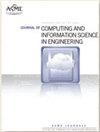基于集成学习的波峰焊不平衡数据在线质量检测方法
IF 2.6
3区 工程技术
Q2 COMPUTER SCIENCE, INTERDISCIPLINARY APPLICATIONS
Journal of Computing and Information Science in Engineering
Pub Date : 2023-07-31
DOI:10.1115/1.4063068
引用次数: 0
摘要
波峰焊在线检测是车间检测缺陷产品的重要方法。准确的质量检测可以降低生产成本,并为波峰焊过程中的质量预警提供支持。然而,仍然存在提高缺陷类别的检测精度的问题。尽管数据中的类不平衡可以通过数据级方法(如过采样和欠采样)来解决,但这些方法会破坏原始数据集的完整性,并可能导致信息丢失和过拟合问题。为了解决上述问题,本文重点研究了如何设计一种新的损失函数,该函数融合了焦点损失(FS)的类权重和AdaBoost的样本权重,以在不改变数据分布的情况下提高对少数样本的关注。通过这种方式,构建了一个基于迁移学习的FS AdaBoost RegNet模型,以提高工业环境中的检测精度。最后,以某电子装配车间的波峰焊图像为例,验证了该方法的有效性。在941个不平衡数据集的测试样本上进行的实验表明,具有新损失函数的FS-AdaBoost-RegNet模型的总体准确率达到98.39%,总体召回率达到96.19%。结果证明,与其他方法相比,该方法提高了识别缺陷类的能力本文章由计算机程序翻译,如有差异,请以英文原文为准。
An online quality detection method with ensemble learning on imbalance data for wave soldering
Online detection of wave soldering is an important method of inspecting defective products in the workshop. Accurate quality detection can reduce production costs and provide support for quality warning in wave soldering process. However, there are still problems of improving the detection accuracy for defect class. Although class imbalance in data can be addressed by data level methods such as over-sampling and under-sampling, these methods destroy the integrity of the original data set and may cause information loss and overfitting problems. In order to solve the above problems, this article focuses on how to design a new loss function that fuses class weights from focal loss (FS) and sample weights form AdaBoost to improve attention to the minority samples without changing data distribution. In this way, a FS-AdaBoost-RegNet model based on transfer learning is constructed to enhance the detection accuracy in industrial environment. Finally, the images of the wave soldering from an electronic assembly workshop are taken to validate the performance of the proposed method. The experiment on 941 testing samples of the imbalance datasets showed that the FS-AdaBoost-RegNet model with new loss function reached the overall accuracy of 98.39%, the overall recall of 96.19%. The results proved that the proposed method promotes the ability to identify defect class compared with other methods
求助全文
通过发布文献求助,成功后即可免费获取论文全文。
去求助
来源期刊
CiteScore
6.30
自引率
12.90%
发文量
100
审稿时长
6 months
期刊介绍:
The ASME Journal of Computing and Information Science in Engineering (JCISE) publishes articles related to Algorithms, Computational Methods, Computing Infrastructure, Computer-Interpretable Representations, Human-Computer Interfaces, Information Science, and/or System Architectures that aim to improve some aspect of product and system lifecycle (e.g., design, manufacturing, operation, maintenance, disposal, recycling etc.). Applications considered in JCISE manuscripts should be relevant to the mechanical engineering discipline. Papers can be focused on fundamental research leading to new methods, or adaptation of existing methods for new applications.
Scope: Advanced Computing Infrastructure; Artificial Intelligence; Big Data and Analytics; Collaborative Design; Computer Aided Design; Computer Aided Engineering; Computer Aided Manufacturing; Computational Foundations for Additive Manufacturing; Computational Foundations for Engineering Optimization; Computational Geometry; Computational Metrology; Computational Synthesis; Conceptual Design; Cybermanufacturing; Cyber Physical Security for Factories; Cyber Physical System Design and Operation; Data-Driven Engineering Applications; Engineering Informatics; Geometric Reasoning; GPU Computing for Design and Manufacturing; Human Computer Interfaces/Interactions; Industrial Internet of Things; Knowledge Engineering; Information Management; Inverse Methods for Engineering Applications; Machine Learning for Engineering Applications; Manufacturing Planning; Manufacturing Automation; Model-based Systems Engineering; Multiphysics Modeling and Simulation; Multiscale Modeling and Simulation; Multidisciplinary Optimization; Physics-Based Simulations; Process Modeling for Engineering Applications; Qualification, Verification and Validation of Computational Models; Symbolic Computing for Engineering Applications; Tolerance Modeling; Topology and Shape Optimization; Virtual and Augmented Reality Environments; Virtual Prototyping

 求助内容:
求助内容: 应助结果提醒方式:
应助结果提醒方式:


